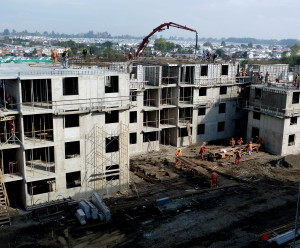Concrete low-rise construction is very popular in the U.S., but older structures pose serious threats during an earthquake.
An “alarming number” of low-rise concrete structures located in major earthquake zones have not been retrofitted for earthquake safety. Concrete buildings located in areas that were not historically prone to seismic activity but which are now experiencing high amounts of it, such as Oklahoma and Texas, are in especial danger.
Engineer Reginald DesRoches, chair of Georgia Tech’s school of Civil and Environmental Engineering explains that “There are hundreds of thousands of buildings that have not been retrofitted that … [and] are very dangerous.”
These 2- to 5-story structures were built to the code standards of their day, but those outdated standards are nowhere near as safe as today’s building codes. These older buildings were not designed to bend, stretch, and endure seismic shifts like contemporary buildings are. In states like Oklahoma and Missouri that are experiencing an uptick in seismic activity, this lack of seismic retrofitting may prove to be even more dangerous.
These older cement structures are referred to as “non-ductile reinforced concrete.” This means that they are brittle, rigid, and vulnerable to seismic shock. In earthquakes of 7.8 magnitude of higher, these buildings fail catastrophically. For example, much of the damage in Nepal was due to an abundance of non-ductile reinforced concrete buildings. “We know from past earthquakes,” says DesRoches, that “non-ductile reinforced concrete buildings don’t perform well in earthquakes, all around the world … They collapse.”
70% of Nepal’s concrete buildings were built from non-ductile reinforced concrete, which contributed greatly to the death toll of the quake. Photo Courtesy of Wikimedia Commons.
Until 1980, non-ductile concrete construction was prevalent throughout most of the U.S.. The exception was California, which had phased our non-ductile concrete construction in the 1950s in favor of the ductile engineering. While many brittle buildings have been retrofitted to combat seismic shocks, there are hundreds more that have not been and are likely to collapse in the event of high-impact earthquakes.
According to the U.S. Federal Emergency Management Agency (FEMA), these non-retrofitted buildings are “the single biggest contributor” to earthquake damages in the nation. Aging brick structures built with the unreinforced masonry (URM) technique are also extremely vulnerable to seismic shock. In fact, current building codes in many places prohibit new URM in areas of high seismic activity. However, areas that had not experienced historically volatile seismic activity until recently have several URM structures that are perilously close to newly sparked seismic centers.
To combat the fragility of these URMs and non-ductile concrete buildings, there are a number of retrofitting options. Installing concrete sheer walls with closely spaced reinforcements and spiral reinforcement is one method of retrofitting. Adding diagonal steel reinforcements to existing walls is the most popular option. Both options are expensive and time-consuming, which is why many property owners forego seismic retrofitting, despite the incredible dangers.
DesRoches’s team at Georgia Tech is currently studying the best way to effectively retrofit these vulnerable buildings. Last year, they built a non-ductile concrete low-rise parking structure such as those ubiquitous garages built prior to the 1950’s throughout the U.S. DesRoches’ team then subjected the building to a simulated earthquake, courtesy of a mobile shaker borrowed from the Network for Earthquake Engineering Simulation.
Repeated testing confirmed the fragility of unreinforced structures, but also pointed the way to new reinforcement techniques. Carbon-fiber jacket wrapping along each column seems promising, but sealing a layer of grout between the carbon-fiber wrapping and the columns is more promising still. The most promising new technology is the bendable nickel titanium alloy that DesRoches developed. This smart material, which DesRoches calls a “shape memory alloy,” can withstand “a significant amount of displacement and then just springs right back,” DesRoches says.”
DesRoches’ team is now analyzing the testing data to determine retrofit options and research-based results which can then be presented to the International Code Council. It is hoped that the ICC and other organizations will confirm the results through duplicate testing, and then use the overall research findings to update the building code.
Better, less expensive seismic retrofitting options will enable property owners and developers to make their aging concrete structures safer and more durable. DesRoches thinks that “many people think there’s nothing you can do about an earthquake other than hope it doesn’t happen” while they are lin the building or the area. Testing is beginning to show that, “in fact, there are fairly straightforward ways that you can retrofit a structure to significantly improve this behavior, so that either it doesn’t collapse or even is fully operational after an earthquake.”
DesRoches believes that these new retrofitting options will “save lives, but also … keep hospitals, schools and businesses as functional as possible.”


